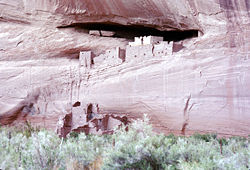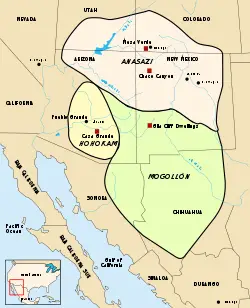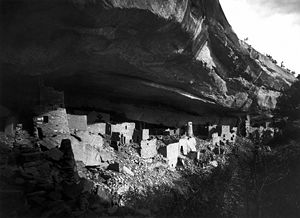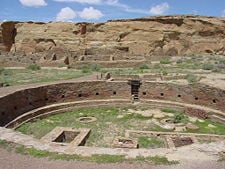Ancient Pueblo Peoples
- "Anasazi" redirects here.
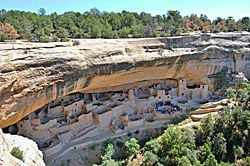
Ancient Pueblo People or Ancestral Pueblo peoples were an ancient Native American culture centered on the present-day Four Corners area of the United States, comprising southern Utah, northern Arizona, northwest New Mexico, and southern Colorado. They lived in "houses" called pueblos in which they lifted up ladders during enemy attacks, providing the Pueblo peoples security. The cultural group has often been referred to in archaeology as the Anasazi, although the term is not preferred by contemporary Pueblo peoples.
Archaeologists still debate when this distinct culture emerged. The current consensus, based on terminology defined by the Pecos Classification, suggests their emergence around the 12th century B.C.E., during the archaeologically designated Basketmaker II Era. Beginning with the earliest explorations and excavations, researchers postulated that the Ancient Puebloans are ancestors of the modern Pueblo peoples. In general, modern Pueblo people claim these ancient people as their ancestors.
Etymology
The name pueblo was given by the Spanish explorers who arrived in the Southwestern part of what is now the United States in the early sixteenth century, and means in the Spanish language "village." In general, modern Pueblo people claim these ancient people as their ancestors.
The cultural group has often been referred to in archaeology as the Anasazi, although the term is not preferred by contemporary Pueblo peoples. Archaeologist Linda Cordell discussed the word's etymology and use:
The name "Anasazi" has come to mean "ancient people," although the word itself is Navajo, meaning "enemy ancestors." [The Navajo word is anaasází (anaa- "enemy," sází "ancestor").] The term was first applied to ruins of the Mesa Verde by Richard Wetherill, a rancher and trader who, in 1888–1889, was the first Anglo-American to explore the sites in that area. Wetherill knew and worked with Navajos and understood what the word meant. The name was further sanctioned in archaeology when it was adopted by Alfred V. Kidder, the acknowledged dean of Southwestern Archaeology. Kidder felt that it was less cumbersome than a more technical term he might have used. Subsequently some archaeologists who would try to change the term have worried that because the Pueblos speak different languages, there are different words for "ancestor," and using one might be offensive to people speaking other languages.[1]
David Roberts, explained his reason for using the term "Anasazi" over a term using "Puebloan," noting that the latter term "derives from the language of an oppressor who treated the indigenes of the Southwest far more brutally than the Navajo ever did."[2]
Some modern Pueblo peoples object to the use of the term Anasazi, although there is still controversy among them on a native alternative. The Hopi use the term Hisatsinom meaning the "ancient people"; another alternative is the Tewa language Se'da, meaning the "ancient ones."[3]
History
The Ancient Pueblo Peoples (Anasazi) were one of four major prehistoric archaeological traditions recognized in the American Southwest. The others are the Mogollon, Hohokam and Patayan. In relation to neighboring cultures, the Ancient Pueblo occupied the area known as the "Four Corners," a region consisting of the southwestern corner of Colorado, northwestern corner of New Mexico, northeastern corner of Arizona, and southeastern corner of Utah.Cite error: Closing </ref> missing for <ref> tag Early Pueblo I sites may have housed up to 600 individuals in a few separate but closely spaced settlement clusters. However, they were generally occupied for a mere 30 years or less. Archaeologist Timothy A. Kohler excavated large Pueblo I sites near Dolores, Colorado, and discovered that they were established during periods of above-average rainfall. This would allow crops to be grown without benefit of irrigation. At the same time, nearby areas experiencing significantly drier patterns were abandoned.
The ancient Pueblos attained a cultural "Golden Age" between about 900 and 1130. During this time, generally classed as Pueblo II, the climate was relatively warm and rainfall mostly adequate. Communities grew larger and were inhabited for longer periods of time. Highly specific local traditions in architecture and pottery emerged, and trade over long distances appears to have been common. Domesticated turkeys appear.[citation needed]
After approximately 1150, North America experienced significant climatic change in the form of a 300-year drought called the Great Drought. This also led to the collapse of the Tiwanaku civilization around Lake Titicaca in present-day Bolivia.[4] The contemporary Mississippian culture also collapsed during this period. Confirming evidence is found in excavations of the western regions of the Mississippi Valley between 1150 and 1350, which show long-lasting patterns of warmer, wetter winters and cooler, drier summers. In this later period, the Pueblo II became more self-contained, decreasing trade and interaction with more distant communities. Southwest farmers developed irrigation techniques appropriate to seasonal rainfall, including soil and water control features such as check dams and terraces. The population of the region continued to be mobile, abandoning settlements and fields under adverse conditions. Along with the change in precipitation patterns, there was a drop in water table levels due to a different cycle unrelated to rainfall. This forced the abandonment of settlements in the more arid or over-farmed locations.[citation needed]
Evidence suggests a profound change in religion in this period. Chacoan and other structures constructed originally along astronomical alignments, and thought to have served important ceremonial purposes to the culture, were systematically dismantled. Doorways were sealed with rock and mortar. Kiva walls show marks from great fires set within them, which probably required removal of the massive roof - a task which would require significant effort. Habitations were abandoned, tribes split and divided and resettled far elsewhere. This evidence suggests that the religious structures were deliberately abandoned slowly over time. Puebloan tradition holds that the ancestors had achieved great spiritual power and control over natural forces, and used their power in ways that caused nature to change, and caused changes that were never meant to occur. Possibly, the dismantling of their religious structures was an effort to symbolically undo the changes they felt they caused due to their abuse of their spiritual power, and thus make amends with nature.
Most modern Pueblo peoples (whether Keresans, Hopi, or Tanoans) assert the ancient Pueblo did not "vanish," as is commonly portrayed in media presentations or popular books, but migrated to areas in the southwest with more favorable rainfall and dependable streams. They merged into the various Pueblo peoples whose descendants still live in Arizona and New Mexico. This perspective is not new. It was presented by early 20th century anthropologists, including Frank Hamilton Cushing, J. Walter Fewkes and Alfred V. Kidder. Many modern Pueblo tribes trace their lineage from settlements. For example, the San Ildefonso Pueblo people believe that their ancestors lived in both the Mesa Verde and the Bandelier areas. Evidence also suggests that a profound change took place in the Anasazi area and areas inhabited by their cultural neighbors, the Mogollon. The contemporary historian James W. Loewen agrees with the oral traditions in his book, Lies Across America: What Our Historic Markers and Monuments Get Wrong (1999), but there is not a consensus within the professional academic community.
Stress on the environment may have been reflected in the social structure, leading to conflict and warfare. Near Kayenta, Arizona, Jonathan Haas of the Field Museum in Chicago has been studying a group of Ancient Pueblo villages that relocated from the canyons to the high mesa tops during the late 13th century. The only reason Haas can see for a move so far from water and arable land is defense against enemies. He asserts that isolated communities relied on raiding for food and supplies, and that internal conflict and warfare became common in the 13th century. This conflict may have been aggravated by the influx of less settled peoples, Numic-speakers such as the Utes, Shoshones and Paiute people, who may have originated in what is today California. Others suggest that more developed villages, such as that at Chaco Canyon overstressed their environment, resulting in widespread deforestation and eventually the fall of their civilization through warfare over depleted resources.
A 1997 excavation at Cowboy Wash near Dolores, Colorado, found remains of at least twenty-four human skeletons that showed evidence of violence and dismemberment, with strong indications of cannibalism. This modest community appears to have been abandoned during the same time period.[5] Other excavations within the Ancient Pueblo culture area produce varying numbers of unburied, and in some cases dismembered, bodies.[6] This evidence of warfare, conflict, and cannibalism is hotly debated by some scholars and interest groups. Suggested alternatives include: a community under the pressure of starvation or extreme social stress, dismemberment and cannibalism as religious ritual or in response to religious conflict, the influx of outsiders seeking to drive out a settled agricultural community via calculated atrocity, or an invasion of a settled region by nomadic raiders who practiced cannibalism; such peoples have existed in other times and places, e.g. the Androphagi of Europe.
Culture
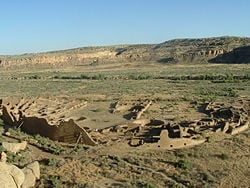
The Ancient Pueblo culture is perhaps best-known for the stone and adobe dwellings built along cliff walls, particularly during the Pueblo II and Pueblo III eras. Adobe structures are constructed with bricks created from sand, clay, and water, with some fibrous or organic material, shaped using frames and dried in the sun. The best-preserved examples of the stone and adobe dwellings are in National Parks (USA), such as Chaco Canyon or Chaco Culture National Historical Park, Mesa Verde National Park, Aztec Ruins National Monument, Bandelier National Monument, Hovenweep National Monument, and Canyon de Chelly National Monument. These villages, called pueblos by Spanish settlers, were often only accessible by rope or through rock climbing. These astonishing building achievements had more modest beginnings. The first Ancestral Puebloan homes and villages were based on the pit-house, a common feature in the Basketmaker periods.
Ancestral Puebloans are also known for their pottery. In general, pottery was used for cooking or storage in the region was unpainted gray, either smooth or textured. In the northern or "Anasazi" portion of the Ancestral Pueblo world, from about 500 to 1300 C.E., the most common decorated pottery had black painted designs on white or light gray backgrounds. Decoration is characterized by fine hatching, and contrasting colors are produced by the use of mineral-based paint on a chalky background. Some tall cylinders are considered ceremonial vessels, while narrow-necked jars may have been used for liquids. Ware in the southern portion of the region, particularly after 1150 C.E., is characterized by heavier black-line decoration and the use of carbon-based colorants.[7] In northern New Mexico, the local "black on white" tradition, the Rio Grande white wares, continued well after 1300 C.E.
Changes in pottery composition, structure and decoration are signals of social change in the archaeological record. This is particularly true as the peoples of the American Southwest began to leave their traditional homes and migrate south. According to archaeologists Patricia Crown and Steadman Upham, the appearance of the bright colors on Salada Polychromes in the 14th century may reflect religious or political alliances on a regional level. Late 14th and 15th century pottery from central Arizona, widely traded in the region, has colors and designs which may derive from earlier ware by both Anasazi and Mogollon peoples. (Cordell, p. 142-143)
The Ancestral Puebloans also created many petroglyphs and pictographs.
Architecture - Pueblo complexes and Great Houses
The Ancestral Puebloan People crafted a unique architecture with planned community spaces. The ancient population centers such as Chaco Canyon (outside Crownpoint, NM), Mesa Verde (outside Cortez, CO), and Bandelier (outside Los Alamos, NM) for which the Ancestral Puebloans are renowned, consisted of apartment-like complexes and structures made from stone, adobe mud, and other local material, or were carved into the sides of canyon walls. Each were influenced by themselves and design details from other cultures as far away as modern-day Mexico. In their day, these ancient towns and cities were usually multi-storied and multi-purposed buildings surrounding open plazas and viewsheds and were occupied by hundreds to thousands of Ancestral Puebloan People. These population complexes hosted cultural and civic events and infrastructure that supported a vast outlying region hundreds of miles away linked by transportation roadways.
Constructed well before 1492 C.E., these Ancestral Puebloan towns and villages in the Southwestern U.S. were located in various defensive positions, for example, on high steep mesas such as at Mesa Verde or present-day Acoma "Sky City" Pueblo, in New Mexico. Earlier than 900 C.E. progressing past the 13th century, the population complexes were a major center of culture for the Ancient Pueblo Peoples. In Chaco Canyon, Chacoan developers quarried sandstone blocks and hauled timber from great distances, assembling 15 major complexes which remained the largest buildings in North America until the 19th century.[8][9] Evidence of archaeoastronomy at Chaco has been proposed, with the Sun Dagger petroglyph at Fajada Butte a popular example. Many Chacoan buildings may have been aligned to capture the solar and lunar cycles,[10] requiring generations of astronomical observations and centuries of skillfully coordinated construction.[11] Climate change is thought to have led to the emigration of Chacoans and the eventual abandonment of the canyon, beginning with a 50-year drought in 1130.[12]
Great Houses
Immense complexes known as "Great Houses" embodied worship at Chaco. As architectural forms evolved and centuries passed, the houses kept several core traits. Most apparent is their sheer bulk; complexes averaged more than 200 rooms each, and some enclosed up to 700 rooms.[11] Individual rooms were substantial in size, with higher ceilings than Anasazi works of preceding periods. They were well-planned: vast sections or wings erected were finished in a single stage, rather than in increments. Houses generally faced the south, and plaza areas were almost always girt with edifices of sealed-off rooms or high walls. Houses often stood four or five stories tall, with single-story rooms facing the plaza; room blocks were terraced to allow the tallest sections to compose the pueblo's rear edifice. Rooms were often organized into suites, with front rooms larger than rear, interior, and storage rooms or areas.
Ceremonial structures known as kivas were built in proportion to the number of rooms in a pueblo. One small kiva was built for roughly every 29 rooms. Nine complexes each hosted an oversized Great Kiva, each up to 63 feet (19 m) in diameter. T-shaped doorways and stone lintels marked all Chacoan kivas. Though simple and compound walls were often used, Great Houses were primarily constructed of core-and-veneer walls: two parallel load-bearing walls comprising dressed, flat sandstone blocks bound in clay mortar were erected. Gaps between walls were packed with rubble, forming the wall's core. Walls were then covered in a veneer of small sandstone pieces, which were pressed into a layer of binding mud.[13] These surfacing stones were often placed in distinctive patterns. The Chacoan structures altogether required the wood of 200,000 coniferous trees, mostly hauled—on foot—from mountain ranges up to 70 miles (110 km) away.[14][15]
Ceremonial Infrastructure - Great North Road: the thirty foot wide highway
One of the most fascinating and intriguing aspects of Ancestral Puebloan infrastructure is at Chaco Canyon and is the Chaco Road, a system of roads radiating out from many great house sites such as Pueblo Bonito, Chetro Ketl and Una Vida, and leading towards small outlier sites and natural features within and beyond the canyon limits.
Through satellite images and ground investigations, archaeologists have detected at least 8 main roads that together run for more than 180 miles (ca 300 km), and are more than 30 feet (10 m) wide. These were excavated into a smooth leveled surface in the bedrock or created through the removal of vegetation and soil. The Ancestral Puebloan (Anasazi) residents of Chaco Canyon cut large ramps and stairways into the cliff rock to connect the roadways on the ridgetops of the canyon to the sites on the valley bottoms.
The largest roads, constructed at the same time as many of the great house sites (between 1000 and 1125 C.E.), are: the Great North Road, the South Road, the Coyote Canyon Road, the Chacra Face Road, Ahshislepah Road, Mexican Springs Road, the West Road and the shorter Pintado-Chaco Road. Simple structures like berms and walls are found sometimes aligned along the courses of the roads. Also, some tracts of the roads lead to natural features such as springs, lakes, mountain tops and pinnacles.
The Great North Road
The longest and most famous of these roads is the Great North Road. The Great North Road originates from different routes close to Pueblo Bonito and Chetro Ketl. These roads converge at Pueblo Alto and from there lead north beyond the Canyon limits. There are no communities along the road's course, apart from small, isolated structures.
Archaeological interpretations of the Chaco road system are divided between an economic purpose and a symbolic, ideological role linked to ancestral Puebloan beliefs.
The system was first discovered at the end of the 19th century, and first excavated and studied in the 1970s. Archaeologists suggested that the road's main purpose was to transport local and exotic goods inside and outside the canyon. Someone also suggested that these large roads were used to quickly move an army from the canyon to the outlier communities, a purpose similar to the road systems known for the Roman empire. This last scenario has long been discarded because of the lack of any evidence of a permanent army.
The economic purpose of the Chaco road system is shown by the presence of luxury items at Pueblo Bonito and elsewhere in the canyon. Items such as macaws, turquoise, marine shells, and imported vessels prove the long-distance commercial relations Chaco had with other regions. A further suggestion is that the widespread use of timber in Chacoan constructions—a resource not locally available—needed a large and easy transportation system. Through analysis of various strontium isotopes, archaeologists have realized that much of the timber that composes Chacoan construction came from a number of distant mountain ranges, indicative also of the Chaco Road's economic significance.
Ancient Religion and Road Building
Chaco Road Religious Significance: Other archaeologists think instead that the main purpose of the road system was a religious one, providing pathways for periodic pilgrimages and facilitating regional gatherings for seasonal ceremonies. Furthermore, considering that some of these roads seem to go nowhere, experts suggest that they can be linked—especially the Great North Road—to astronomical observations, solstice marking, and agricultural cycles.
This religious explanation is supported by modern Pueblo beliefs about a North Road leading to their place of origin and along which the spirits of the dead travel. According to modern pueblo people, this road represents the connection to the shipapu, the place of emergence of the ancestors or a dimensional doorway. During their journey from the shipapu to the world of the living, the spirits stop along the road and eat the food left for them by the living.
What Archaeology tells us About the Chaco Road: Astronomy certainly played an important role in Chaco culture, as it is visible in the north-south axis alignment of many ceremonial structures. The main buildings at Pueblo Bonito, for example, are arranged according to this direction and probably served as central places for ceremonial journeys across the landscape.
Sparse concentrations of ceramic fragments along the North Road have been related to some sort of ritual activities carried out along the roadway. Isolated structures located on the roadsides as well as on top of the canyon cliffs and ridge crests have been interpreted as shrines related to these activities.
Finally, features such as long linear grooves were cut into the bedrock along certain roads which do not seem to point to a specific direction. It has been proposed that these were part of pilgrimage paths followed during ritual ceremonies.
Archaeologists agree that the purpose of this road system may have changed through time and that the Chaco Road system probably functioned for both economic and ideological reasons. Its significance for archaeology lies in the possibility to understand the rich and sophisticated cultural expression of ancestral Puebloan societies.
Cliff Palace Communities and design
Through out the southwest Ancient Puebloan region and at Mesa Verde, the best known site for these large number of well preserved cliff dwellings, housing, defensive and storage complexes were built in shallow caves and under rock overhangs along canyon walls. The structures contained within these alcoves were mostly blocks of hard sandstone, held together and plastered with adobe mortar. Specific constructions had many similarities, but were generally unique in form due to the individual topography of different alcoves along the canyon walls. In marked contrast to earlier constructions and villages on top of the mesas, the cliff dwellings at Mesa Verde reflected a region-wide trend towards the aggregation of growing regional populations into close, highly defensible quarters during the 13th century.
While much of the construction in these sites conforms to common Pueblo architectural forms, including Kivas, towers, and pit-houses, the space constrictions of these alcoves necessitated what seems to have been a far denser concentration of their populations. Mug House, a typical cliff dwelling of the period, was home to around 100 people who shared 94 small rooms and eight kivas built right up against each other and sharing many of their walls; builders in these areas maximized space in any way they could and no areas were considered off-limits to construction.[15]
Not all of the people in the region lived in cliff dwellings; many colonized the canyon rims and slopes in multi-family structures that grew to unprecedented size as populations swelled.[15] Decorative motifs for these sandstone/mortar constructions, both cliff dwellings and non-, included T-shaped windows and doors. This has been taken by some archaeologists, such as Stephen Lekson (1999), as evidence of the continuing reach of the Chaco Canyon elite system, which had seemingly collapsed around a century before.[16] Other researchers see these motifs as part of a more generalized Puebloan style and/or spiritual significance, rather than evidence of a continuing specific elite socioeconomic system.[17]
Cultural distinctions
Archaeological cultural units such as "Anasazi," Hohokam, Patayan or Mogollon are used by archaeologists to define material culture similarities and differences that may identify prehistoric socio-cultural units, equivalent to modern societies or peoples. The names and divisions are classification devices based on theoretical perspectives, analytical methods and data available at the time of analysis and publication. They are subject to change, not only on the basis of new information and discoveries, but also as attitudes and perspectives change within the scientific community. It should not be assumed that an archaeological division or culture unit corresponds to a particular language group or to a socio-political entity such as a tribe.
When making use of modern cultural divisions in the American Southwest, it is important to comprehend that current terms and conventions have significant limitations:
- Archaeological research focuses on items left behind during people’s activities: fragments of pottery vessels, garbage, human remains, stone tools or evidence left from the construction of dwellings. However, many other aspects of the culture of prehistoric peoples are not tangible. Their beliefs and behavior are difficult to decipher from physical materials, and their languages remain unknown as they had no known writing system.
- Cultural divisions are tools of the modern scientist, and so should not be considered similar to divisions or relationships the ancient residents may have recognized. Modern cultures in this region, many of whom claim some of these ancient people as ancestors, contain a striking range of diversity in lifestyles, social organization, language and religious beliefs. This suggests the ancient people were also more diverse than their material remains may suggest.
- The modern term "style" has a bearing on how material items such as pottery or architecture can be interpreted. Within a people, different means to accomplish the same goal can be adopted by subsets of the larger group. For example, in modern Western cultures, there are alternative styles of clothing that characterized older and younger generations. Some cultural differences may be based on linear traditions, on teaching from one generation or “school” to another. Other varieties in style may have distinguished between arbitrary groups within a culture, perhaps defining status, gender, clan or guild affiliation, religious belief or cultural alliances. Variations may also simply reflect the different resources available in a given time or area.
Defining cultural groups, such as the Ancient Pueblo peoples, tends to create an image of territories separated by clear-cut boundaries, like border boundaries separating modern states. These simply did not exist. Prehistoric people traded, worshipped, collaborated and fought most often with other nearby groups. Cultural differences should therefore be understood as “clinal,” "increasing gradually as the distance separating groups also increases".[18] Departures from the expected pattern may occur because of unidentified social or political situations or because of geographic barriers. In the Southwest, mountain ranges, rivers and, most obviously, the Grand Canyon can be significant barriers for human communities, likely reducing the frequency of contact with other groups. Current opinion holds that the closer cultural similarity between the Mogollon and Ancient Pueblos and their greater differences from the Hohokam and Patayan is due to both the geography and the variety of climate zones in the Southwest.
Notable Puebloan sites
- Aztec Ruins National Monument
- Bandelier National Monument
- Canyon de Chelly National Monument
- Chaco Culture National Historical Park
- Gila Cliff Dwellings National Monument
- Hovenweep National Monument
- Mesa Verde National Park
Notes
- ↑ Linda S. Cordell, Ancient Pueblo Peoples (Washington DC: Smithsonian Books, 1994, ISBN 978-0895990389), 18-19.
- ↑ David D. Roberts, In Search of the Old Ones: Exploring the Anasazi World of the Southwest (New York, NY: Simon & Schuster, 1996, ISBN 978-0684810782).
- ↑ L. Michael Smith, Anasazi Hisatsinom: Sky Scraper Builders, 1998. Retrieved June 20, 2011.
- ↑ "Mountains of Evidence", in American Scientist
- ↑ LeBlanc p.174
- ↑ Tim White, Prehistoric cannibalism at Mancos 5MTUMR-2346, Princeton, 1992, ISBN 0-691-09467-5
- ↑ Cordell, pp. 98
- ↑ Strutin 1994, p. 6
- ↑ Fagan 2005, p. 35
- ↑ Fagan 1998, pp. 177–182
- ↑ 11.0 11.1 Sofaer 1997
- ↑ Fagan 2005, p. 198
- ↑ Fagan 2005, pp. 119–121
- ↑ Sofaer 1999
- ↑ 15.0 15.1 15.2 Kantner, John (2004). "Ancient Puebloan Southwest," pp. 161-66
- ↑ Lekson, Stephen (1999). "The Chaco Meridian: centers of Political Power in the Ancient Southwest." Walnut Creek, Altamira Press
- ↑ Phillips, David A., Jr., 2000, "The Chaco Meridian: A skeptical analysis" paper presented to the 65th annual meeting of the Society of American Archaeology, Philadelphia.
- ↑ Plog, p. 72.
ReferencesISBN links support NWE through referral fees
- Childs, Craig. House of Rain: Tracking a Vanished Civilization Across the American Southwest. New York, NY: Little, Brown and Company, 2007. ISBN 978-0316608176
- Cordell, Linda S. Ancient Pueblo Peoples. Washington DC: Smithsonian Books, 1994. ISBN 978-0895990389
- Fagan, Brian M. Ancient North America: The Archaeology of a Continent. New York, NY: Thames and Hudson, Inc., 1995. ISBN 978-0500050750
- Fagan, Brian M. Chaco Canyon: Archaeologists Explore the Lives of an Ancient Society. New York, NY: Oxford University Press, 2005. ISBN 978-0195170436
- Fagan, Brian M. From Black Land to Fifth Sun: The Science of Sacred Sites. New York, NY: Basic Books, 1998. ISBN 978-0201959918
- Jennings, Jesse D. Glen Canyon: An Archaeological Summary. Salt Lake City, UT: University of Utah Press, 1998. ISBN 978-0874805840
- Kidder, Alfred V. An Introduction to the study of Southwestern Archaeology. New Haven, CT: Yale University Press, 2000. ISBN 978-0300082975
- LeBlanc, Steven A. Prehistoric Warfare in the American Southwest. Salt Lake City, UT: University of Utah Press, 1999. ISBN 978-0874805819
- Plog, Stephen. Ancient Peoples of the American Southwest. London: Thames and Hudson, 1997. ISBN 978-0500279397
- Pritzker, Barry M. A Native American Encyclopedia. New York, NY: Oxford University Press, 2000. ISBN 978-0195138771
- Roberts, David D. In Search of the Old Ones: Exploring the Anasazi World of the Southwest. New York, NY: Simon & Schuster, 1996. ISBN 978-0684810782
- Sofaer, Anna. "The Primary Architecture of the Chacoan Culture: A Cosmological Expression." In Anasazi Architecture and American Design, edited by Baker H. Morrow and V. B. Price. Albuquerque, NM: University of New Mexico Press, 1997. ISBN 978-0826317797
- Sofaer, Anna. Chaco Astronomy: An Ancient American Cosmology. Santa Fe,NM: Ocean Tree Books, 2007. ISBN 978-0943734460
- Toll, Catherine M., and H. Wolcott Toll. "Deciphering the Organization of Production in Chaco Canyon (Organization of Production at Chaco Canyon conference papers)." American Antiquity 66 (1) (Jan 2001): 5.
- Waldman, Carl. Encyclopedia of Native American Tribes. New York, NY: Checkmark Books, 2006. ISBN 978-0816062744
- Waldman, Carl. Atlas of the North American Indian. New York, NY: Checkmark Books, 2009. ISBN 978-0816068593
External links
All links retrieved June 18, 2011.
- Bandelier National Monument Virtual Museum Exhibit and Lesson Plans, from National Park Service
- Chaco Culture National Historic Park Virtual Museum Exhibit, from National Park Service
- Chaco Culture World Heritage Convention
- The Anasazi or Ancient Pueblo peoples
- The Anasazi: The People of the Mountains, Mesas and Grasslands
- The Chaco Meridian
- Oral Tradition and History of the Ancient People
- Mesa Verde
- Aztec Ruins National Monument
- Hovenweep National Monument
- Gila Cliff Dwellings National Monument
- Canyon de Chelly National Monument
Credits
New World Encyclopedia writers and editors rewrote and completed the Wikipedia article in accordance with New World Encyclopedia standards. This article abides by terms of the Creative Commons CC-by-sa 3.0 License (CC-by-sa), which may be used and disseminated with proper attribution. Credit is due under the terms of this license that can reference both the New World Encyclopedia contributors and the selfless volunteer contributors of the Wikimedia Foundation. To cite this article click here for a list of acceptable citing formats.The history of earlier contributions by wikipedians is accessible to researchers here:
The history of this article since it was imported to New World Encyclopedia:
Note: Some restrictions may apply to use of individual images which are separately licensed.
